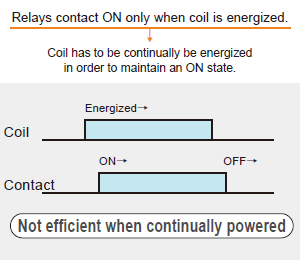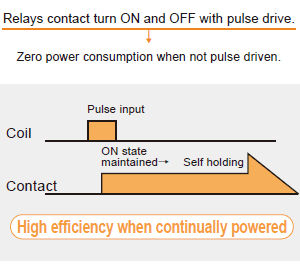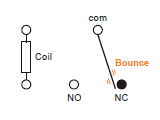1.Difference between Polarized and Non-polarized Relays
| | Non-polarized | Polarized |
|---|
| Main relays | LQ | DS-P, DK, ST |
|---|
| Contact arrangement | 1a, 1c | 1a, 1b, 1c, 2a, 2b, 2c, 1a1b, 4a, 4c, 2a2b, 3a1b |
|---|
| Latching type | Without | With |
|---|
Nominal operating power
(Comparison: 10A type) | LQ relays 200 mW
(1 Form A contact only) | DK relays 200 mW |
|---|
| Vibration and shock resistance | Weak compared to polarized relays. | Strong compared to non-polarized relays. |
|---|
2.Features of polarized power relay
Latching type
Coil power consumption can be controlled, because ON or OFF state of relay contact can be held using pulse input (zero power consumption when there is no pulse drive).
| Non-polarized (non-latching) type | Polarized (latching) type |
|---|
| Current flows endlessly through coil 
| Power saving realized with pulse drive 
|
High sensitivity
When compared under the same contact capacity, the polarized relays are more sensitive than non-polarized relays.
| Compared with 10 A switching capacity | LQ relays 200 mW (1 Form A contact only) |
|---|
| DK relays 200 mW |
Superior vibration resistance
| Vibration resistance (Functional) | LQ relays 10 to 55 Hz (double amplitude of 1.6 mm) |
|---|
| DK relays 10 to 55 Hz (double amplitude of 3 mm) |
Superior NC (b contact) switching ability
Contact bouncing when resetting is controlled thanks to power of permanent magnet.
NC switching ability at same level as NO (a contact) is maintained.
● During relay reset
| Non-polarized type | Polarized type |
|---|
Bouncing is pronounced, because resetting is carried out only by the power of the contact string.
⇒ Much damage to the contact
| Positive resetting to NC thanks to the double power of contact spring and permanent magnet.
⇒ Little damage to the contact
|
Power Relays (for General Use) Related Information




